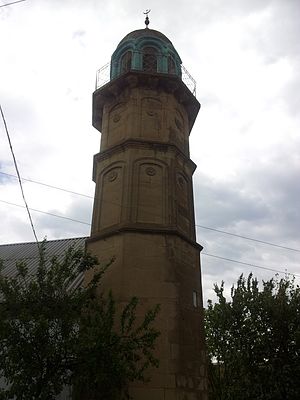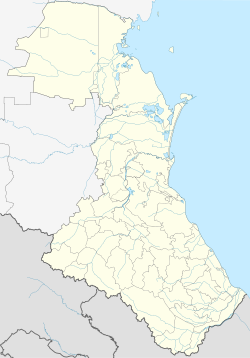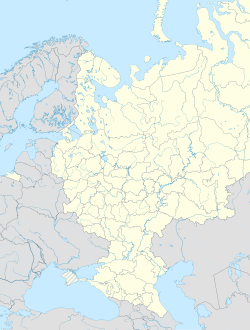Endirey (Russian: Эндирей; OKATO: 82254815001) is a village (selo) in the Khasavyurt District of the Republic of Dagestan in Russia. It is the center of the Endireyskoe Rural Settlement and has a population of 7,863 (2015). Endirey is an important historical center of the Kumyks.
Endirey
Эндирей | |
|---|---|
| Other transcription(s) | |
| • Kumyk | Endirey, Эндирей |
| Coordinates: 43°10′50″N 46°39′19″E / 43.18056°N 46.65528°E | |
| Country | Russia |
| Federal subject | Dagestan |
| Elevation | 40 m (130 ft) |
| Time zone | UTC+3 (MSK |
| Postal code(s)[2] | |
| OKTMO ID | 82654409101 |

Its current head is Salavatov Rustam Abdulvagidovich.
Name
editEndirey is an ancient original Kumyk name. It was adopted by Daghestan in 1991, replacing the Soviet name Andreyaul (Андрейаул). Under Imperial Russia, its name had been Andreyevo (Андреево, Andreevo) after an early Cossack leader who supposedly settled there, a Russian source quotes many alleged explanations.[3] [4] Former spellings include Enderi,[5] Enderee,[3] Indiri and al-Indiri,[6][7] Andreeva,[5] and Andreewa. It has also been known as Andreevskii Awul.[6]
Location
editEndirey lies at the foot of Mount Tshumlu[8] on the Aktash River near Khasavyurt, just north of the Caucasus and just east of the Chechen border.[6] It lies about 72 kilometers (45 mi) south of Kizliar[5] and has a mean elevation of 40 meters (130 ft).
History
editThe area preserves the ruins of a fortress destroyed by Tamerlane during the Tokhtamysh–Timur war.[9]
The early history Endirey is uncertain.[10] During the Safavid period (1501–1736), the small Kumyk's kingdom of Endirey formed somewhat of a "buffer state" towards the north.[11] Feodor I dispatched Prince Grigori Zasekin against the local shamkhal in 1591. His force of 5000 Russian musketeers and 10,000 Cherkesses captured and razed Andreyevo the next year, wounding the shamkhal.[12] Relations with the nearby Circassians were, however, generally friendly prior to the Cossacks' submission to Peter the Great in 1712, after which raiding and invasions became more common.[13] In a belated response to the 1707 burning of the Russian fort at Tarki, Peter the Great dispatched a unit of cavalry to occupy Endirey in 1722 as part of his Persian campaign. The force suffered a serious repulse and the area was left alone for several decades.[14]
Endirey had a large slave trade to the Ottoman Empire[5] and became the principal city of the Kumyks.[15]
General Yermolov constructed a major fort at Vnezapnaya in 1820, placing it across the Aktash from Endirey[7] at the mouth of the Koysu.[16] This fort was used to suppress the Endirey slave fair[17] and to support the local shamkhal against the Kumyk nobility.[16][18] It supported Russian colonization of the area: the revolts the program provoked (as Imam Shamil's in the 1840s and Haji Mohammed's in 1877) were an expected consequence and were seen as permitting still greater relocation and resettlement.[18] The fort also formed the staging point for the 1839 phase of the Caucasian War.[19] General Grabbe's siege of Akhoulgo formed part of this campaign. The town and fort were assaulted by Shamil in September 1843 but the Russian commander Colonel Kozlovsky was able to withstand the attack.[20]
In the later 19th century, it had a population of around 12,000 people[5] comprising about 3000 households.[8] The district around it included fertile agricultural valleys but also sandy desert, mineral springs, and upwellings of naphtha.[8] Despite continuing as a Kumyk protectorate,[8] it formed part of the Russian Empire's district of the Caucasus.[5][8]
Demographics
editThe area around Endirey is currently majority Sunni Muslim Kumyks - 6,025 (93,1 %).
See also
editReferences
editCitations
edit- ^ "Об исчислении времени". Официальный интернет-портал правовой информации (in Russian). 3 June 2011. Retrieved 19 January 2019.
- ^ Почта России. Информационно-вычислительный центр ОАСУ РПО. (Russian Post). Поиск объектов почтовой связи (Postal Objects Search) (in Russian)
- ^ a b Baddeley (1908), p. 8.
- ^ Дагестанские исторические сочинения, Амри Шихсаидов, Т. Айтберов, Гасан Оразаев, 1993
- ^ a b c d e f "Andreeva".
- ^ a b c Tucker (2004), p. 251.
- ^ a b Tucker (2004), p. 252.
- ^ a b c d e Knight (1866).
- ^ Ministry of Culture (2015).
- ^ Before 06may2016 this article had the following, which appears in a number of places, but is questionable " Andreyevo was allegedly settled by the Don Cossack ataman Andréya Shádrin around 1580, following his erection of a new fortress near Tarki on the Caspian. Shádrin was said to have moved south partially owing to tensions with his rival Yermak Timofeyevich. The settlement may have predated this, however, with Mountain Cossacks having settled the Terek Basin as early as the 1520s. " For doubts see footnotes to North Caucasus Line and Barrett, At the Edge of Empire, page 15. This Tarki is probably confused with Tersky Gorod.
- ^ Floor 2001, pp. 87–88.
- ^ Allen (1970), p. 370.
- ^ Jaimoukha, pp. 30–31.
- ^ Dunlop (1998), p. 7.
- ^ Wagner (1854), p. 180.
- ^ a b Moser (1856), p. 112–113.
- ^ Herman (1845), p. 14.
- ^ a b Khodarkovsky (2011), p. 60–61.
- ^ "Caucasus Mountains Archived 2015-05-30 at the Wayback Machine".
- ^ Baddeley (1908), p. 368.
Bibliography
edit- Allen, W.E.D., ed. (1970), Russian Embassies to the Georgian Kings (1589–1605), Vol. II (PDF), Anthony Mango, trans., Glasgow: Robert MacLehose & Co. for the Cambridge University Press for the Hakluyt Society, archived from the original (PDF) on 2015-05-31, retrieved 2015-05-31.
- "Andreeva" in the Encyclopædia Britannica, 9th ed., Vol. II, p. 20.
- Astapenko, Mikhail, Donskiye Kazach'i Atamany (Don Cossack Atamans).
- "Caucasus Mountains", Memim Encyclopedia, 2015.
- Baddeley, John Frederick (1908), The Russian Conquest of the Caucasus with Maps, Plans, and Illustrations, London: Longmans, Green, & Co..
- Dunlop, John B. (1998), Russia Confronts Chechnya: Roots of a Separatist Conflict, Cambridge: Cambridge University Press, ISBN 0-521-63619-1.
- Floor, Willem (2001). Safavid Government Institutions. Costa Mesa, California: Mazda Publishers. ISBN 978-1568591353.
- Herman, G.F. (1845), "The Theatre of War in the Caucasus", Colburn's United Service Magazine and Naval and Military Journal, vol. 1845 Pt. I, London: Harrison & Co. for Henry Colburn, pp. 9–18.
- Jaimoukha, Amjad, "A Brief History of Kabarda from the Seventh Century AD", Circassian Culture & Folklore.
- Khodarkovsky, Michael (2011), Bitter Choices: Loyalty and Betrayal in the Russian Conquest of the North Caucasus, Ithaca: Cornell University Press, ISBN 978-0-8014-4972-7.
- Knight, Charles, ed. (1866), "Andreewa", Geography, or, First Division of The English Cyclopædia, Vol. I, London: Bradbury, Evans, & Co., Col. 362.
- Ministry of Culture of the Republic of Dagestan (2015), "Хасавюртовский район (Khasavyurovskii raion, Khasavyurt District)", Official Website. (in Russian)
- Moser, Louis (1856), The Caucasus and its People, with a Brief History of their Wars, and a Sketch of the Achievements of the Renowned Chief Schamyl, London: T. Richards for David Nutt.
- Tucker, Ernest (2004), "Glossary", Russian-Muslim Confrontation in the Caucasus: Alternative visions of the conflict between Imam Shamil and the Russians, 1830–1859, London: RoutledgeCurzon, ISBN 0-415-32590-0.
- Wagner, Friedrich (1854), Mackenzie, Kenneth (ed.), Schamyl and Circassia, 2d ed., London: G. Routledge & Co.



